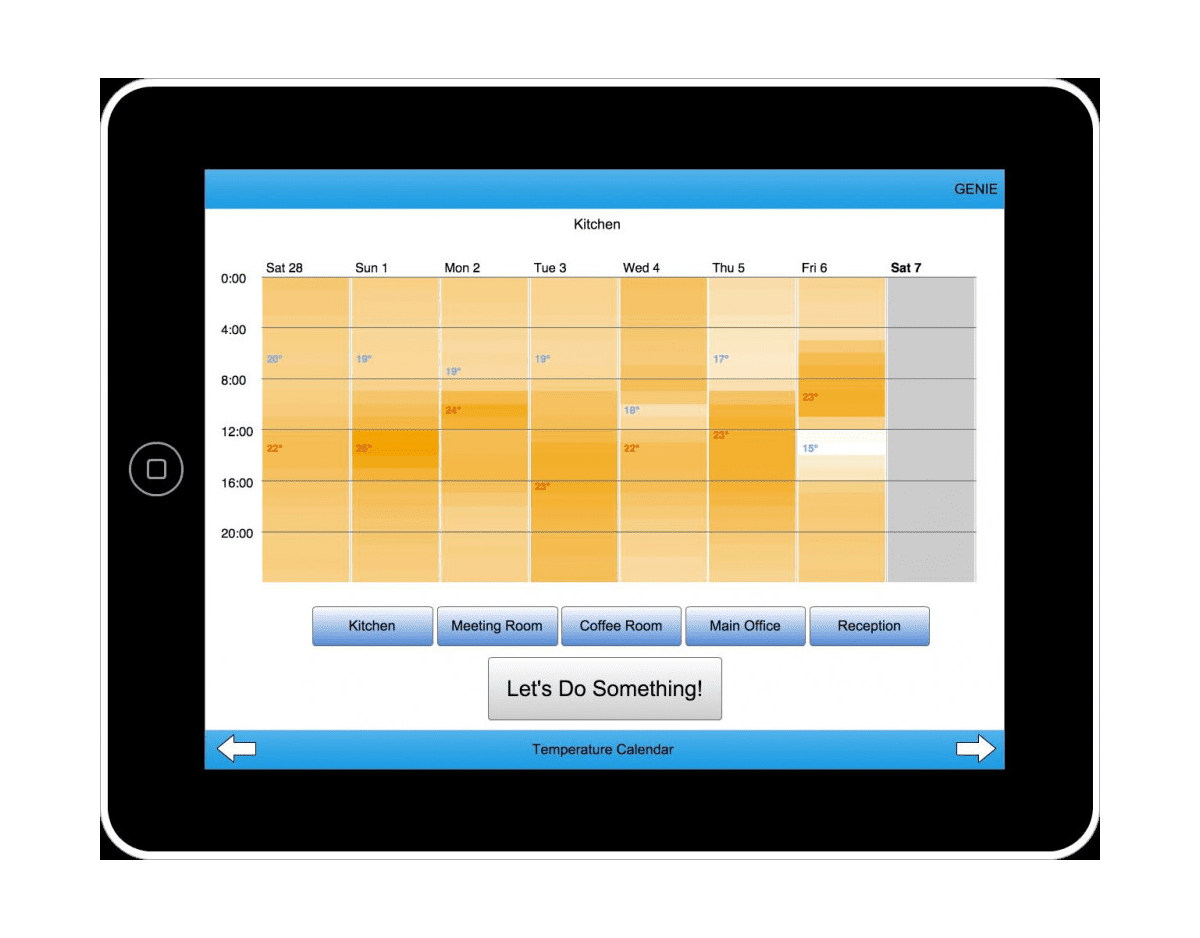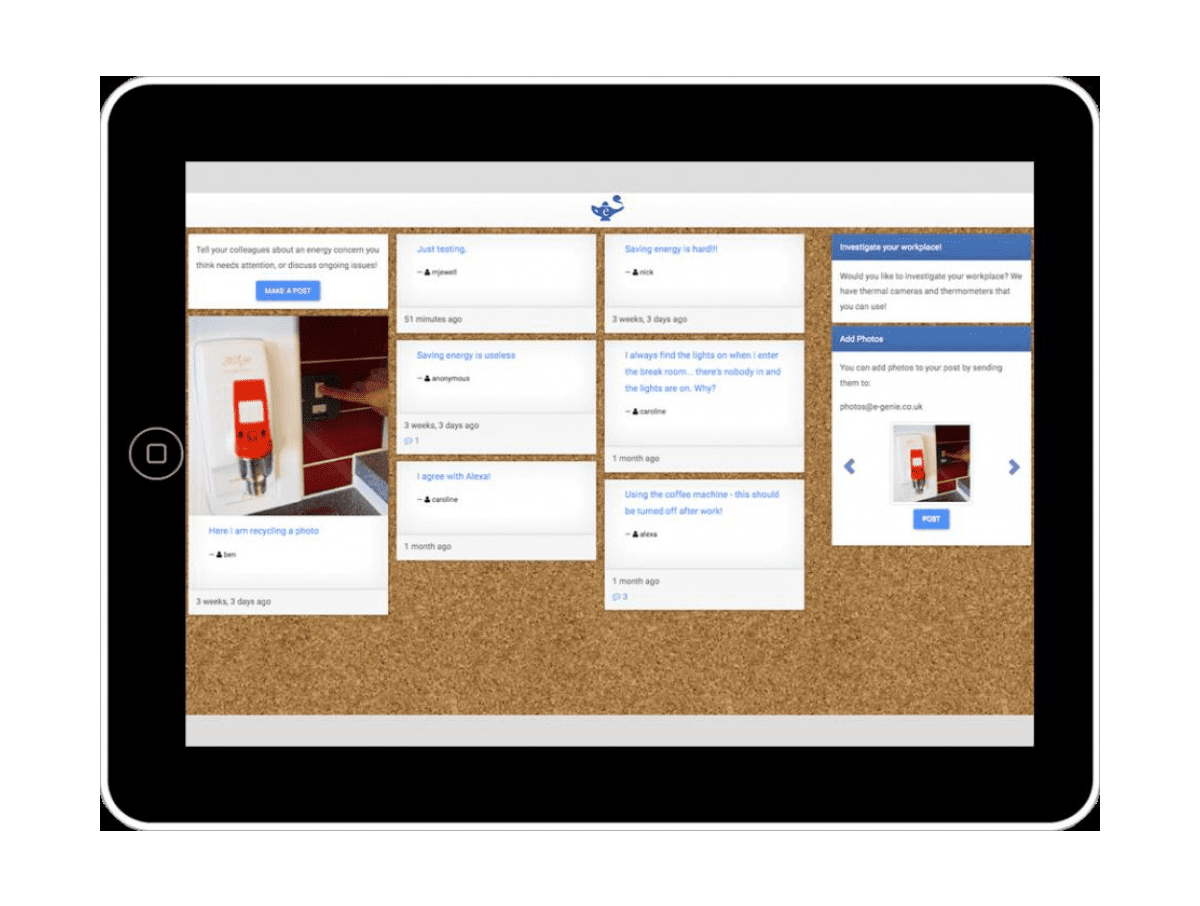C-tech toolkit
This work was completed as a legacy of the C-tech project, Creating the Energy for Change, a five-year research project investigating innovative ways of dividing up and representing energy use in shared buildings to motivate occupants to save energy. You can find out more and read the final report this project here.
The C-tech toolkit
The toolkit is suitable for most workplaces however it is primarily designed with large offices in mind where the way that staff use the services and equipment is an important factor driving energy consumption.
The toolkit has five main elements:
- The e-Genie web application for visualising and engaging people with energy use.
- A workplace energy audit tool.
- Energy workshop templates and plans.
- Guidance on designing energy engagement communications.
- A friendly summary of the key points from the academic papers produced by the C-tech project.
A guide to using the toolkit which includes links to downloads to the tools is available A guide to using the toolkit which includes links to downloads to the tools is available here..
Creating the energy for change
The tools deliver a number of benefits:
- Increases in energy literacy of staff and facilities management – the tools visualise energy use giving staff new insight into what consumes energy at what time.
- Increased engagement with energy use as an issue and the need to use it carefully. Using the toolkit allows building users to understand the “story” of energy use in their building.
- A process for co-designing with building users a behaviour change and energy management strategy.
- Guidance on the design of supporting materials based on the social psychology of the workplace.
- Provides impetus for staff to undertake small measures in the workplace through the pledging tool.
Changing behaviours
Evaluation of the toolkit found that staff were significantly more concerned about energy issues and reported engaging more in social energy behaviour after about two weeks of the e-Genie energy visualisation tool being installed.
In addition electricity use decreased over the same period, and continued decreasing over subsequent weeks (ref Digital energy visualizations in the workplace: the e-Genie tool. Spence et al (2018) Building Research & Information, 46:3, 272-283).
The heart of the toolkit is the e-Genie application. This is a software application that gives energy and temperature data visualisations to building occupants on dedicated screens. It also has functions to allow staff to make pledges to change their behaviours and creates a pin board space where energy issues can be identified and possible solutions crowdsourced.
e-genie functions
Energy consumption dashboard
An energy consumption dashboard, providing data on workplace electricity use. Live information can be annotated by staff, so that they can link particular activities with their energy footprint, while weekly views let staff track how their energy consumption has changed over the course of the week

Temperature calendar
A temperature calendar, which shows half hourly temperature measurements over the previous week up to the present moment. This can be shown for multiple areas, allowing staff to understand how air temperatures relate to their comfort requirements in particular parts of the building.

Discussion space
A discussion space, where staff are encouraged to identify energy-related issues in the workplace, and crowdsource potential solutions.

Planning tool
A planning tool through which staff can commit to a goal of reducing their energy footprint and are guided through a process of planning changes they could make.

Communications channel
A communications channel to the Facilities Manager (or equivalent role within the organisation) who holds responsibility for workplace energy management

e-genie is available as an open source resource from GitHub.
We know that visualisations of energy and temperature data aren’t enough to prompt behaviour change on their own. Staff need an opportunity to talk through the energy data and begin to understand the “story” of energy use in their workplace.
To support this, CSE developed a set of supporting workshops and other materials.
Workshop templates guide users through a set of exercises which are designed to uncover how energy is used in the space, issues of comfort and control and to work towards behavioural and technical solutions. The information from e-Genie can feed directly into the workshop discussions. Three workshops have been developed designed to be delivered in sequence:
- Introduction and mapping. This introduces staff to the e-Genie toolkit. They are then asked to map their activities in the workspace, their comfort levels and the technologies used to achieve comfort within their building.
- Apportionment. This workshop is about using data to work out what and who consumes energy. It also aims to identify who has control or influence over energy consuming practices.
- Causality and Strategy. In the final workshop the work of the previous workshops is brought together, solutions are identified and prioritised before finally being reviewed using the Capability, Opportunity and Motivation (COM-B) behaviour change framework.
e-Genie, in tandem with the workshops increases staff energy literacy and engagement with energy use and creates the buy-in needed for successful behaviour change interventions.
Workshop templates can be downloaded here.
The energy audit tool is also designed to generate information about how energy is used within the organisation (the various end uses – heating, lighting etc) but also to provide insight into the way that it is used – to consider the energy management and behavioural dimensions. It asks questions such as who has control of heating settings, is there scope for shifting some end uses out of peak times, why do staff control the lighting as they do? This information also feeds into the workshopping process.
The energy audit tool has also been designed so that a technically confident facilities manager can benchmark the performance of their office and also explore the energy and carbon saving potential of various measures. Where measures are found to hold promise they too can be tested in the workshopping process.
The energy audit tools are available for download here:
- Spreadsheet for calculation of benchmarks, end use consumption and savings from measures (Excel doc).
- AEIOU framework for observing behaviour in the workplace (PDF).
- Proforma for capturing technical and behavioural data (Excel doc).
- Energy managers interview topic guide (Excel doc).
Energy management options and issues for consideration can also be captured by e-Genie’s pinboard. As staff identify faults or have suggestions for improvements the pinboard offers a place where these can be recorded. Facilities managers are able to view the pinboard and respond. Issues can be brought into the workshop process and solutions explored.
Engagement with staff also can be improved by paying attention to design of communications materials – notices, emails etc can all be designed using principles drawn from social psychology. The toolkit contains some guidance on this drawn from the research.
Once interventions have been designed and implemented their effects can be monitored using the egenie tools. For example, changes in temperature in a space can be identified. This information should then be fed back to staff to support behavioural change.
Finally, the toolkit contains a digest of the research papers generated by the Ctech project, intended for use by facilities managers in the design of awareness raising and communications strategy as part of a wider behaviour change programme.


